Perennials, Take Two
- Caroline Fanning
- Mar 19, 2019
- 3 min read

Here’s a sure-fire sign of spring—the chickens are back in the field. Steve is relieved, having towed the coops down the muddy back road and come fairly close to sliding into a ditch. Judy is anxious, given that a late-winter snowfall could still throw a big wrench into chicken chores. The chickens, as best I can tell, are unimpressed. They went from pecking bare dirt up at the Tin House to pecking bare dirt out in the fields. Truth be told, we could have given them better forage—there are several fields where winter peas are peeping up, and the girls would love to tear into that. But they’re here to work, just like all us, and right now we need them to work their magic in the soon-to-be-kale beds. As recently as four months ago, these beds were full of carrots, so there was no chance to get a cover crop planted. So yes, the chickens may be grumbling now, but they’ll be fine—in two weeks, they’ll literally be moving on to greener pastures.
The weather has been mild enough to induce thoughts of early seeding. That said, we know the value of playing it safe. Even if the air is warm, the soil is still cold, and it would only take a few twenty-degree nights to bring us back to February. So to keep busy while we wait for spring to truly arrive, we attend to the perennials—pruning the berries, cleaning up the herb beds, etc. I’m excited to get at it, and I haven’t been this excited in years. Perennials are an important feature of most diversified farms, but for us they’ve had a somewhat tortured history. Back in 2007, when the farm was a blank slate, Dan and I happily devoted entire fields to berries, asparagus, and rhubarb, so eager were we to get ourselves established. But we planted more than we could care for, and it wasn’t long before weeds, shade, and drainage issues overwhelmed us. After feeling sheepish about it for several years, I decided to start over, reasoning it was better than continuing to limp along. In the fall of 2017, we began prepping new blueberry beds, adding woodchips and sulfur to achieve the right soil acidity. We’d hoped to plant new bushes last spring, but when the pH was still too high, we decided to hold off another year. Now we’re ready to plant. It’ll be three to five years before we get a harvest, so in the meantime, we’ll continue caring for our original bushes in the berry field.

Despite the blueberry delay, we did manage to plant both strawberries and raspberries in Chapel Field last spring. We’re confident the strawberries will be fine, since we treat them like annuals. Raspberries, however, are a different story. In 2008, we planted nine hundred feet in a field full of mugwort, not knowing how much handweeding would be involved. In years that followed, many volunteers filled their fingers with raspberry thorns as they beat back the weeds, but the weeds always returned. By 2015, we’d had enough. Sad as we were to surrender, we understood the necessity of it, and we disked the rows under. In 2018, we started over, but with several major changes. For one, we only planted 260 feet. Second, the beds are starting out relatively weed-free. Third, the beds are narrow. Taken together, these changes should give us an edge on the weeds. We expect our first harvest this fall, and our hope is that by the end of the season, we’ll have learned that we can handle more. From an emotional standpoint, it’s much easier to add acreage than to take it away.

The blackberries, for the record, will remain put. They’re the only perennial that thrives in the berry field, and we’re not inclined to mess with success. In fact, last year, on a whim, we planted an extra row, as Glenn happened to be getting rid some of his plants. I once read that blackberries can break through the foundation of a house. If that’s true, it should surprise no one that they can break through the compacted clay soil of the berry field.





















Comments